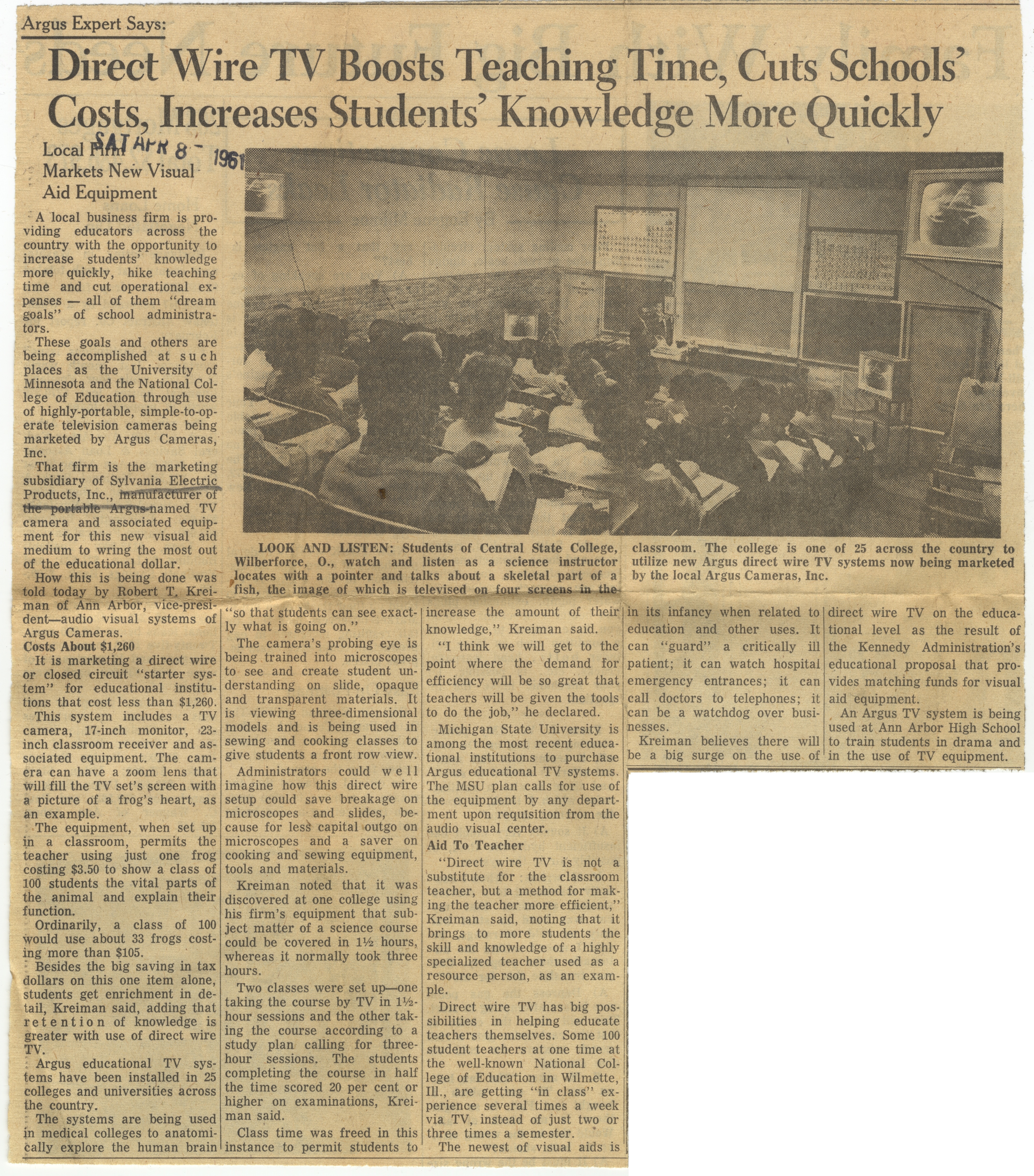Argus Expert Says: Direct Wire TV Boosts Teaching Time, Cuts School Costs, Increases Students' Knowledge More Quickly

Argus Expert Says:
Direct Wire TV Boosts Teaching Time, Cuts Schools’ Costs, Increases Students’ Knowledge More Quickly
Local Firm Markets New Visual Aid Equipment
A local business firm is providing educators across the country with the opportunity to increase students’ knowledge more quickly, hike teaching time and cut operational expenses — all of them “dream goals” of school administrators.
These goals and others are being accomplished at such places as the University of Minnesota and the National College of Education through use of highly-portable, simple-to-operate television cameras being marketed by Argus Cameras, Inc.
That firm is the marketing subsidiary of Sylvania Electric Products, Inc., manufacturer of the portable Argus-named TV camera and associated equipment for this new visual aid medium to wring the most out of the educational dollar.
How this is being done was told today by Robert T. Kreiman of Ann Arbor, vice-president—audio visual systems of Argus Cameras.
Costs About $1,260
It is marketing a direct wire or closed circuit “starter system” for educational institutions that cost less than $1,260.
This system includes a TV camera, 17-inch monitor, 23-inch classroom receiver and associated equipment. The camera can have a zoom lens that will fill the TV set’s screen with a picture of a frog’s heart, as an example.
The equipment, when set up in a classroom, permits the teacher using just one frog costing $3.50 to show a class of 100 students the vital parts of the animal and explain their function.
Ordinarily, a class of 100 would use about 33 frogs costing more than $105.
Besides the big saving in tax dollars on this one item alone, students get enrichment in detail, Kreiman said, adding that retention of knowledge is greater with use of direct wire TV.
Argus educational TV systems have been installed in 25 colleges and universities across the country.
The systems are being used in medical colleges to anatomically explore the human brain “so that students can see exactly what is going on.”
The camera’s probing eye is being trained into microscopes to see and create student understanding on slide, opaque and transparent materials. It is viewing three-dimensional models and is being used in sewing and cooking classes to give students a front row view.
Administrators could well imagine how this direct wire setup could save breakage on microscopes and slides, because for less capital outgo on microscopes and a saver on cooking and sewing equipment, tools and materials.
Kreiman noted that it was discovered at one college using his firm’s equipment that subject matter of a science course could be covered in 1 1/2 hours, whereas it normally took three hours.
Two classes were set up—one taking the course by TV in 1 1/2 hour sessions and the other taking the course according to a study plan calling for three-hour sessions. The students completing the course in half the time scored 20 per cent or higher on examinations, Kreiman said.
Class time was freed in this instance to permit students to increase the amount of their knowledge," Kreiman said.
"I think we will get to the point where the demand for efficiency will be so great that teachers will be given the tools to do the job,” he declared.
Michigan State University is among the most recent educational institutions to purchase Argus educational TV systems. The MSU plan calls for use of the equipment by any department upon requisition from the audio visual center.
Aid To Teacher
“Direct wire TV is not a substitute for the classroom teacher, but a method for making the teacher more efficient,” Kreiman said, noting that it brings to more students the skill and knowledge of a highly specialized teacher used as a resource person, as an example.
Direct wire TV has big possibilities in helping educate, teachers themselves. Some 100 student teachers at one time at the well-known National College of Education in Wilmette, Ill., are getting “in class" experience several times a week via TV, instead of just two or three times a semester.
The newest of visual aids is in its infancy when related to education and other uses. It can “guard” a critically ill patient; it can watch hospital emergency entrances; it can call doctors to telephones; it can be a watchdog over businesses.
Kreiman believes there will be a big surge on the use of direct wire TV on the educational level as the result of the Kennedy Administration’s educational proposal that provides matching funds for visual aid equipment.
An Argus TV system is being used at Ann Arbor High School to train students in drama and in the use of TV equipment.
[image]: LOOK AND LISTEN: Students of Central State College, Wilberforce, O., watch and listen as a science instructor locates with a pointer and talks about a skeletal part of a fish, the image of which is televised on four screens in the classroom. The college is one of 25 across the country to utilize new Argus direct wire TV systems now being marketed by the local Argus Cameras, Inc.